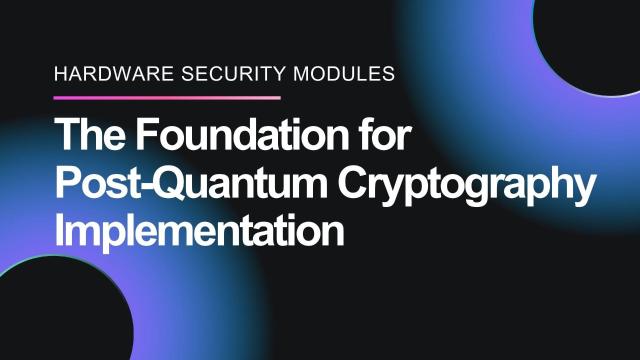Hardware Security Modules: Foundation for Post- Quantum Cryptography Implementation
With NIST’s release of the final standards for Post-Quantum Cryptography (PQC), organizations are tasked with securely and efficiently implementing these complex algorithms. Hardware Security Modules (HSMs) stand out as a key component in this process, providing the robust infrastructure needed to manage post-quantum cryptographic operations while ensuring strong security.
Overview of New PQC Standards
NIST has released three final standards for post-quantum cryptographic algorithms:
FIPS-203 (ML-KEM): Module-Lattice-Based Key-Encapsulation Mechanism based on CRYSTALS- Kyber for key encapsulation.
FIPS-204 (ML-DSA): Module-Lattice-Based Digital Signature Algorithm based on CRYSTALS- Dilithium for digital signatures.
FIPS-205 (SLH-DSA): Stateless Hash-based Digital Signature Algorithm based on SPHINCS+ for hash- based digital signatures.
These algorithms differ significantly from traditional cryptography, often necessitating larger key sizes and increased computational resources. Adapting to these changes necessitates specialized hardware and software, rendering HSMs indispensable for secure implementation.
Why HSMs Are Crucial for PQC
HSMs play several key roles in deploying post-quantum cryptography:
1. Secure Key Generation and Storage
Modern HSMs provide:
High-quality entropy for generating post-quantum keys
Secure storage for large PQC keys
Lifecycle management for quantum-resistant keys
2. Crypto-Agility Support
To facilitate the transition, HSMs provide:
Simultaneous support for both traditional and post-quantum algorithms
Hybrid cryptography options for smoother migration
Flexible algorithm selection and management capabilities
3. Performance Optimization
Since PQC algorithms are resource-intensive, HSMs mitigate this by providing:
Hardware acceleration to manage the larger key sizes and signatures
Optimized processing for complex PQC operations
4. Compliance and Audit Support
To meet regulatory and security standards, HSMs provide:
FIPS 140-2 and 140-3 validations for compliance
Secure audit logging for all cryptographic operations
Role-based access control to restrict key management
Key Factors in Choosing an HSM for PQC
When selecting an HSM for post-quantum cryptography, consider these criteria:
Algorithm Support:
Verify support for NIST’s standardized PQC algorithms
Look for hybrid cryptography capabilities to support both PQC and traditional algorithms
Check the vendor’s roadmap for future PQC support
Performance Requirements:
Assess throughput for PQC operations, as they demand more processing power
Plan for scalability and potential hardware upgrades
Look for built-in hardware acceleration to handle PQC workloads
Integration Capabilities:
Ensure API compatibility with your existing systems
Confirm support for industry standards
Consider flexibility in deployment options to match your IT environment
Management Features:
Key lifecycle management, including backup and recovery
Monitoring and reporting tools for better visibility
Robust access control to safeguard key usage
Best Practices for PQC Migration Using HSMs
1. Start with an Assessment:
Inventory current cryptographic implementations
Identify systems that need quantum resistance
Evaluate your current HSM capabilities for PQC readiness
2. Implement Hybrid Approaches:
Deploy traditional and post-quantum algorithms side-by-side during the transition
Use HSMs to manage both types of algorithms seamlessly
Test performance and compatibility to identify any bottlenecks
3. Plan for Scale:
Factor in the increased storage and processing needs of PQC
Ensure your HSM capacity can handle larger key sizes and signatures
Prepare for the higher computational demands of post-quantum algorithms
4. Ensure Proper Configuration:
Follow vendor guidelines for implementing PQC
Set up strict access controls and enable audit logging
Monitor performance and adjust configurations as needed
Preparing for the Future of Cryptography
As quantum computing progresses, HSMs will continue to evolve, supporting both existing and emerging cryptographic standards. Organizations should assess their HSM infrastructure now to ensure they can implement NIST’s PQC standards effectively. This proactive approach will help maintain robust cryptographic security through the shift to quantum-resilient encryption.
Implementing post-quantum cryptography is not just about using new algorithms; it also requires a solid foundation to support them. HSMs provide this critical infrastructure, helping organizations adopt quantum- resistant cryptography securely and efficiently.

